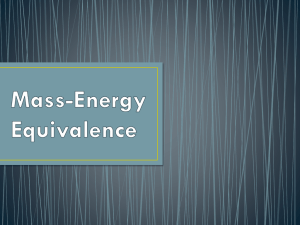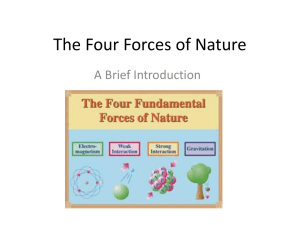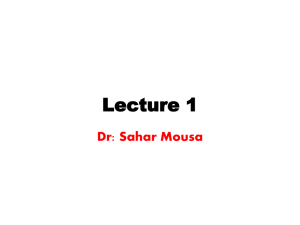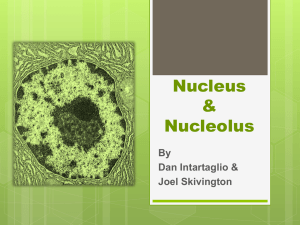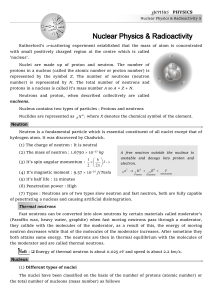Chapter 7 - Bakersfield College
advertisement
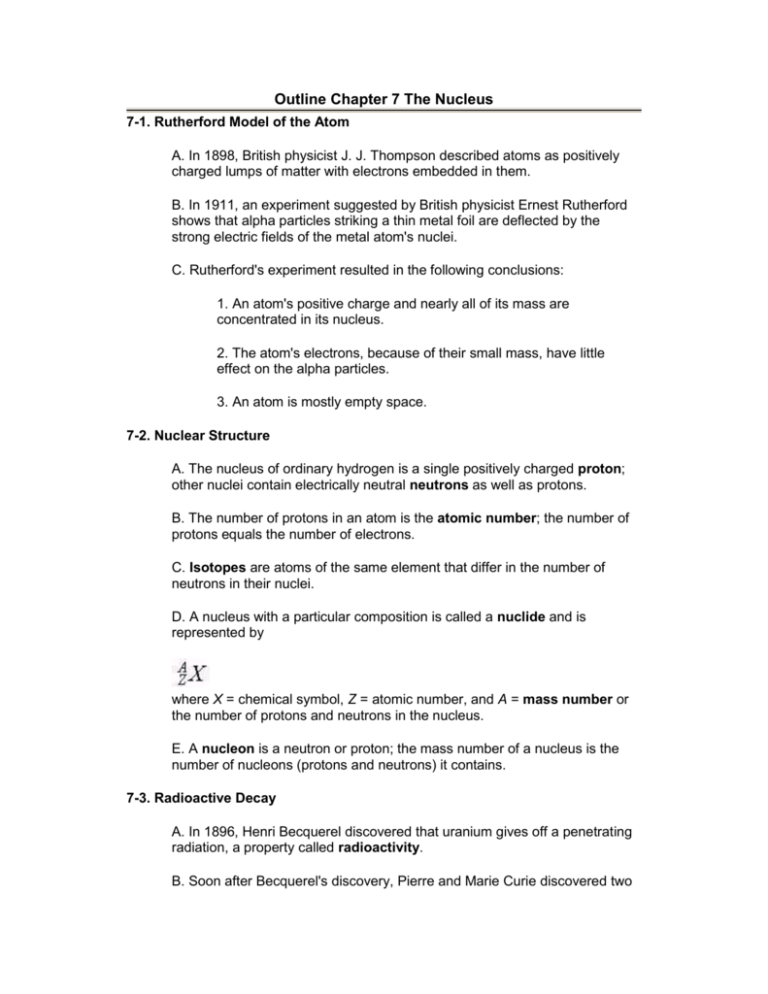
Outline Chapter 7 The Nucleus 7-1. Rutherford Model of the Atom A. In 1898, British physicist J. J. Thompson described atoms as positively charged lumps of matter with electrons embedded in them. B. In 1911, an experiment suggested by British physicist Ernest Rutherford shows that alpha particles striking a thin metal foil are deflected by the strong electric fields of the metal atom's nuclei. C. Rutherford's experiment resulted in the following conclusions: 1. An atom's positive charge and nearly all of its mass are concentrated in its nucleus. 2. The atom's electrons, because of their small mass, have little effect on the alpha particles. 3. An atom is mostly empty space. 7-2. Nuclear Structure A. The nucleus of ordinary hydrogen is a single positively charged proton; other nuclei contain electrically neutral neutrons as well as protons. B. The number of protons in an atom is the atomic number; the number of protons equals the number of electrons. C. Isotopes are atoms of the same element that differ in the number of neutrons in their nuclei. D. A nucleus with a particular composition is called a nuclide and is represented by where X = chemical symbol, Z = atomic number, and A = mass number or the number of protons and neutrons in the nucleus. E. A nucleon is a neutron or proton; the mass number of a nucleus is the number of nucleons (protons and neutrons) it contains. 7-3. Radioactive Decay A. In 1896, Henri Becquerel discovered that uranium gives off a penetrating radiation, a property called radioactivity. B. Soon after Becquerel's discovery, Pierre and Marie Curie discovered two more radioactive elements: polonium and radium. C. Radioactive decay occurs when a nucleus emits particles or high frequency em waves. D. There are five kinds of radioactive decay. 1. Alpha decay, in which an alpha particle (He) is emitted from a large, unstable nucleus. 2. Gamma decay, in which very high frequency em waves, or gamma rays, are emitted by nuclei having excess energy. 3. Beta decay, in which an electron is emitted from a nucleus having an unstable neutron to proton ratio; a nuclear neutron changes to a proton and an electron. 4. Positron emission, a type of beta decay in which a positron (a positively charged electron) is emitted from a nucleus having an unstable proton to neutron ratio; a nuclear proton changes to a neutron and a positron. 5. Electron capture, in which the capture of an electron by a nuclear proton changes the proton to a neutron in a nucleus having a high proton to neutron ratio. 7-4. Half-Life A. The half-life of a radionuclide (radioactive nuclide) is the time needed for half of an original sample to decay. B. Half-lives vary widely among radionuclides, ranging from less than a millionth of a second to billions of years. 7-5. Radiation Hazards A. All ionizing radiation is harmful to living tissue. B. The SI unit of radiation dosage is the sievert (Sv); 1 Sv is the amount of radiation having the same biological effects as those produced when 1 kg of body tissue absorbs 1 J of x-rays or gamma rays. C. Some examples of radioactive sources are: 1. radon gas 2. radionuclides in rocks and soil 3. radionuclides that occur naturally in the body 4. nuclear reactors 5. medical x-ray machines 6. cosmic rays 7-6. Units of Mass and Energy A. The atomic mass unit (u) is the standard unit of atomic mass: 1 atomic mass unit = 1 u = 1.66 x 10-27 kg B. The electronvolt (eV) is the energy unit used in atomic physics: 1 electronvolt = 1 eV = 1.60 x 10-19 J C. The megaelectronvolt (MeV) is equal to 1 million eV: 1 megaelectronvolt = 1 MeV = 106 eV = 1.60 x 10-13J D. The energy equivalent of a rest mass of 1 u is 931 MeV. 7-7. Binding Energy A. All atoms have less mass than the combined masses of the particles of which they are composed. 1. When a nucleus is formed, a certain amount of energy is given off due to the action of the forces holding the neutrons and protons together. 2. The energy comes from the mass of the particles that join together. B. The energy equivalent of the missing mass of a nucleus is called the binding energy; the greater the binding energy of a nucleus, the more the energy is needed to break it apart. 7-8. Binding Energy per Nucleon A. For a given nucleus, the binding energy per nucleon is found by dividing the total binding energy of the nucleus by the number of nucleons (protons and neutrons) it contains; the greater the binding energy per nucleon, the more stable the nucleus. B. Nuclear fission is the splitting of a heavy nucleus into two medium-sized ones, each one having less binding energy per nucleon than the original nucleus. C. Nuclear fusion is the joining of two light nuclei to give a single nucleus of medium size having less binding energy per nucleon than the two original nuclei. D. Binding energy makes stable heavier nuclei possible (beyond hydrogen) which in turn accounts for the various elements and forms of matter found in the physical universe. 7-9. Nuclear Fission A. In 1939, uranium-235 was discovered to undergo nuclear fission when struck by a neutron. 1. A nucleus of U-235 absorbs the neutron to become U-236. 2. The U-236 nucleus is unstable and splits into two smaller nuclei. B. A chain reaction is a series of fission reactions spreading through a mass of an unstable radionuclide such as uranium. 1. When a nucleus undergoes fission, two or three neutrons are released and can cause other nuclei to split and begin a chain reaction. 2. The first chain reaction was demonstrated by the Italian physicist Enrico Fermi in Chicago in 1942. C. In a nuclear reactor, fission occurs at a controlled rate. D. In an atomic bomb, uncontrolled fission produces an explosion. 7-10. How a Reactor Works A. A nuclear power plant transforms nuclear energy into electricity. 1. Controlled nuclear fission within the reactor produces heat. 2. The heat is removed by a liquid or gas coolant. 3. The hot coolant converts water into steam. 4. The steam is fed to a turbine that powers an electric generator. B. The chain reaction within a nuclear reactor is controlled by a moderator which slows down neutrons. C. A water-moderated reactor uses the hydrogen in water (H2O) as the moderator; such reactors use enriched uranium as a fuel. 7-11. Plutonium A. When nonfissionable U-238 captures a fast neutron, it eventually forms the fissionable nuclide of plutonium, Pu-239, which can support a chain reaction. B. Plutonium is a transuranium element, meaning that it has an atomic number greater than the 92 of uranium. C. The fissionable plutonium produced in a uranium-fueled reactor can be used as a fuel or in nuclear weapons. 7-12. A Nuclear World? A. Nuclear energy generates about 21 percent of the electricity produced in the United States. B. Questions of safety, costs, and nuclear waste disposal have halted construction of nuclear reactors in the United States. C. Accidents at the Three Mile Island reactor in Pennsylvania in 1979, and at Ukraine's Chernobyl reactor in 1986, have caused some nations to slow down or abandon their nuclear energy programs; other countries still heavily rely on nuclear power. 7-13. Nuclear Fusion A. Nuclear fusion produces tremendous quantities of energy and has the potential of becoming the ultimate source of energy on earth. B. There are three requirements for a fusion reaction: 1. A high temperature of 100 million C or more. 2. A high concentration of nuclei to assure frequent collisions. 3. A confinement time long enough to allow reacting nuclei to give off more energy than is used in the reactor's operation. C. Current fusion research involves the fusion of deuterium nuclei (2H) and tritium nuclei (3H) to form helium nuclei (4He), neutrons, and energy. 1. Most of the energy is carried by the neutrons; one proposal is to use liquid lithium to absorb the energy from the neutrons and carry it to a steam generator which would power a turbine connected to an electric generator. 2. One approach uses strong magnetic fields to contain the reacting material. 3. The pellet method uses laser beams or beams of charged particles (electrons or protons) to heat and compress tiny deuterium-tritium pellets. 7-14. Antiparticles A. An elementary particle cannot be separated into other particles. B. Nucleons (protons and neutrons) are composed of smaller particles called quarks; however, nucleons are considered to be elementary particles because their quarks are so tightly bound that the nucleons cannot be split. C. An antiparticle has the same mass and general behavior as its corresponding elementary particle, but has a charge of opposite sign and differs in certain other respects. D. When an antiparticle and its corresponding elementary particle come together, they undergo annihilation, with their masses turning entirely into energy. E. In the process of pair production, a particle-antiparticle pair materializes from energy. 7-15. Fundamental Interactions A. Four fundamental interactions give rise to all physical processes in the universe; in order of decreasing strength these are: 1. The strong interaction, which holds protons and neutrons together to form atomic nuclei. 2. The electromagnetic interaction, which gives rise to electric and magnetic forces between charged particles. 3. The weak interaction, which, by causing beta decay, helps determine the compositions of atomic nuclei. 4. The gravitational interaction, which is responsible for the attractive force one mass exerts on another. 7-16. Leptons and Hadrons A. Elementary particles can be categorized into two groups based on their response to the strong interaction. 1. Leptons, which are not affected by the strong interaction, have no internal structure. a. Electrons are leptons. b. Neutrinos are leptons that have no charge and very little mass. 2. Hadrons, which are affected by the strong interaction, are composed of quarks; protons and neutrons are hadrons. B. Quarks have two unusual properties: 1. They have fractional charges. 2. They do not exist independently outside of hadrons.

